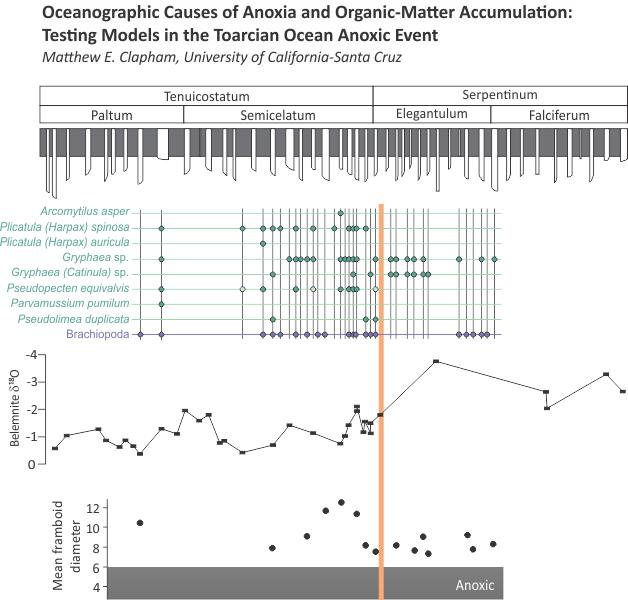Reports: ND854675-ND8: Oceanographic Causes of Anoxia and Organic-Matter Accumulation: Testing Models in the Toarcian Ocean Anoxic Event
Matthew E. Clapham, PhD, University of California, Santa Cruz
We have completed measurements of pyrite framboid diameters on the SEM at NASA-Ames Research Institute (as the UCSC microscope doesn’t have backscatter capabilities). Framboids are rare in most samples; the pyrite fraction is instead dominated by crystalline pyrite. When present, framboids tend to have large and variable diameters (mean size 6-10 mm, Fig. 1). Together, the dominance of crystalline pyrite and the large and variable framboid diameters are consistent with oxic or dysoxic conditions. As previously inferred from sedimentological evidence, there is no evidence for anoxic conditions in either the La Almunia or Sierra Palomera sections, in contrast to the pronounced anoxia in northwest European sections. Mean framboid diameters may be slightly smaller in strata belonging to the Serpentinum zone (coincident with the Toarcian Ocean Anoxic Event, T-OAE), potentially indicating a decrease in local oxygenation, but bottom waters remained oxygenated throughout the section.
2. Isotopic evidence for seasonal water mass properties
Stable isotope analysis has progressed more slowly because of the time required to identify the shells and screen them for diagenesis. Although bivalves record seawater conditions in their shell chemistry, there may be species-specific vital effects. Because of that possibility, it is important to compare measurements within a species, requiring identification of the specimens prior to sectioning and sampling. That process is now complete (Fig. 1), the shells have been screened for diagenesis using cathodoluminescence, and we have begun the isotopic analyses (somewhat delayed due to recent issues with the Kiel carbonate sampler). The preliminary results are promising, in that seasonal signals are preserved in the oxygen isotope record, but we do not yet have sufficient data to assess seasonal differences in d13C or test for potential shifts in seasonal variability across the T-OAE.
3. Personnel involved
Two graduate students continue to work on these projects: Dan Killam and Marko Manojlovic. Dan completed the PhD qualifying exams this past year. Marko began as a PhD student but realized that the academic path was not his goal, so he will complete the MS this fall and start looking for employment (he just interviewed with Exxon’s campus recruiter, hoping for a summer internship). Both students presented their work at the national meeting for the Geological Society of America (Dan also attended and presented at the International Sclerochronology Conference), and both have been successful in obtaining small student research grants to supplement their work.
I mentored a senior thesis student, Andrew Kruger, who helped out with the pyrite framboid data collection. Andrew graduated in June 2016 and is now employed as a Radiometric Data Conditioning analyst for the Deep Space Network of JPL, through one of NASA’s contractors.












